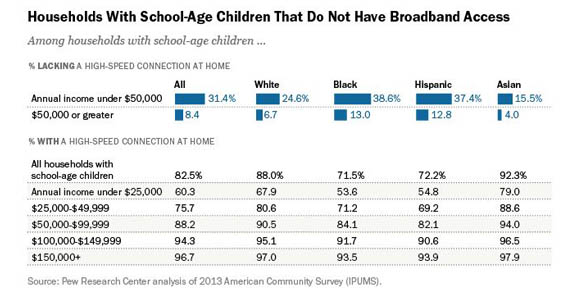
Discussions about the digital divide often focus on technology training for adults and career readiness, but as education shifts its focus towards online resources and learning environments, a major concern is the “homework gap” experienced by many school-age children. The “homework gap” refers to the disadvantages faced by children in households that lack access to broadband services.
An analysis of this broadband “homework gap” by Pew Research Center reveals that approximately 5 million American households with children do not have broadband access. Even more revealing is the fact that households without broadband are predominately black, Hispanic, and low income. Households with children that have an income below $50,000 are 4 times more likely to lack a high-speed internet connection than those above that income marker, and among low-income households with children, blacks and Hispanics are 10 percentage points less likely to have broadband access at home than their white counterparts.
While the FCC’s Lifeline Program is working to revamp their telephone subscription subsidy program so that it would include broadband services, it’s not yet clear how much this would hike up costs and how many of those 5 million households would receive assistance. For the foreseeable future, public libraries are extremely important in helping children and families to close that gap by providing them with access to online educational resources. Providing internet access for school-age children not only affects their ability to get homework done today, but also has bearing on the education and job opportunities available to them in the future.
Read the Pew Research Center’s full analysis of the broadband “homework gap” here.
Note: This post is part of our series, “The Weekly Number.” In this series, we highlight statistics that help tell the story of the 21st-century library.